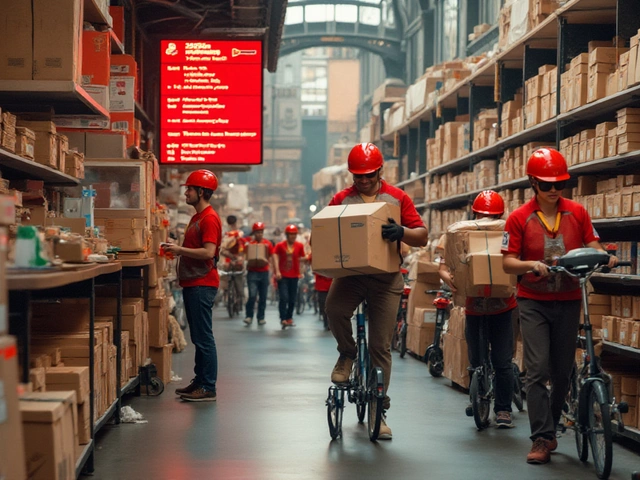Ever wondered if you can just drop a letter in the mailbox and send it halfway across the planet? Holiday postcards, wedding invitations, that proper handwritten apology to a friend on the other side of the world–the classic postal envelope still has a role to play in this era of endless notifications. Sure, everything feels digital now. But regular international mail is alive and well, stubbornly slipping through sorting machines in every country you can name, and a few you probably can’t. It’s not magic, but it sort of feels like it.
How International Regular Mail Works Today
Sending a letter overseas might sound old-fashioned, yet millions still do it daily. The Universal Postal Union (UPU), which now includes more than 190 countries, keeps the mail flowing with rules everyone follows. Fancy sending a birthday card from Auckland to a friend in Lima? Just about every nation is plugged into the same global system.
At the start, you find your local mailbox or post office. In New Zealand, that's NZ Post, but it’s much the same anywhere: letters, postcards, documents, maybe a tiny photo that won’t upset a scanner. You buy postage, slap on the right stamp for your destination–Europe, Asia, North America, wherever. Postage rates aren’t random, though they do creep up. For example, sending a standard envelope from New Zealand to Australia is currently $2.50 NZD, and to the UK it’s $3.30 NZD, but these change yearly. Over 99% of countries support inbound and outbound regular mail—only places in intense conflict or with collapsed postal systems might interrupt service.
The journey of your envelope is wild. After sorting locally, it’s bundled with all international mail. At major hubs—Auckland, Sydney, Singapore, London—it’s sorted by country and whisked off by cargo plane. From there, the destination country’s postal service steps in. Sorting happens again, and your letter is finally delivered by local posties—yet another reason regular mail can take a week in one case and three weeks in another.
Missing a postcode, a detailed return address, or correct postage can cause major headaches. Those are the big potential trip-ups. Letter shape and thickness? Don’t get creative. Uniformity keeps machines happy–thick, weirdly shaped envelopes get delayed or returned. Anything flammable, perishable, or suspicious? Forget it–that's international across the board. Countries also set weird bans: perfumes, seeds, some electronics. Always check the rules first.
People often ask how often regular international mail gets lost. According to 2024 figures from NZ Post, over 97% of international letters arrive safely, though delays certainly happen, especially during holidays, pandemics, or postal strikes. You can usually track larger international letters by adding a registered or tracked service for an extra fee—though basic mail, by default, rarely offers tracking.
The etiquette of ‘Air Mail’ stickers matters less today, since almost all international mail travels by air. That said, putting ‘Air Mail’ or ‘Par Avion’ on your letter can still speed things along, especially in regions with both land and air options.
Customs forms? If you add anything but paper to the envelope (like a bookmark, CD, or keychain), you’ll need a CN22 or CN23 customs declaration. This catches people out at Christmas. Just keeping it to paper? No extra forms or drama.

Tips and Tricks for Sending Regular International Mail
Now, let’s talk hacks. The 'secret' to smooth delivery is attention to detail and following a couple of savvy steps. Don’t rely on being lucky–here’s how to stop your carefully penned letter from falling into a postal black hole.
- Addressing: Write clearly, in block letters, with the country name in big CAPITALS on the last line. Double-check the destination country's address format; the US wants one style, Germany another.
- Postcodes: Double- or triple-check these. A wrong postcode is the fastest way to route your letter wrong or delay delivery for weeks.
- Return address: Never skip it. Letters get lost; without a return address they'll disappear forever.
- Stamps: Make sure you use international postage, not domestic. For heavy or thick envelopes, use a postage calculator on your postal service’s website.
- Timing: Around holidays or public events, international mail piles up. In December, post early—there are Christmas deadlines for each country, published online every year.
- Mail restrictions: Double-check prohibited items for both New Zealand and your destination via their postal authority websites. Japan, for example, bans most batteries and seeds.
- Customs: Non-paper items need forms. Even a tiny fabric heart or pressed flower can trigger delays without the right declaration.
- Tracking and registration: Worried about valuables? Use a registered or tracked service, even for important documents.
- Packaging: Keep envelopes plain. Glitter, string, or metal bits can jam postal machines or cause suspicion at customs.
- Language barrier: If you think the local posties in the destination country might not read your handwriting, print a label or add the address in both English and the local language.
NZ Post, Royal Mail, USPS, and Australia Post all have postage calculators and destination guides online. Smart travelers also keep stamps from various countries for surprise letters—makes the snail mail routine feel like a travel diary.
What about delivery times? Here’s a quick table to set expectations:
| Destination | Expected Delivery (Business Days) |
|---|---|
| Australia | 3-6 |
| USA | 7-12 |
| UK | 8-13 |
| Europe | 8-15 |
| Asia | 7-14 |
Last but not least: fees. Letters rarely attract duties, but if you put something “valuable” in with your papers, customs may hold it. The best move is to keep it simple if it’s not a package. Letters are safe from VAT and tariffs, with rare exceptions.

Challenges and Changes in International Letter Delivery
Regular mail is still fast in some places, but slogs along in others. The pandemic in 2020-2022 caused a historic backlog. Mailbags stacked up in airports for months, showing how tied we are to global flight patterns. Even now, a volcanic eruption or political dispute can pause mail to or from a country overnight. Anyone mailing to Russia, Israel, or Sudan in 2024 will remember sudden suspensions or huge reroutes.
Postal unions constantly tweak their relationships. Since 2020, postage treaties are renegotiated more frequently as e-commerce booms—cheap parcels mean serious postal expenses for some governments. That’s why cross-border postage rises so unpredictably.
Automation is a double-edged sword here. Machines read your handwriting, sort by barcode, and zap letters along conveyors. In places like Germany or New Zealand, that means regular mail can still move fast and reliably. In others, strikes, crumbling infrastructure, or customs pile-ups mean things slow way down, or disappear entirely. Switzerland manages near-perfect reliability (99.5% on-time) while some African countries admit to losing up to 8% of inbound international mail each year.
Ever get a returned envelope with “insufficient address” or “addressee unknown?” Most of the time, it means some small info was missing or out of order. Double-checking address conventions for the country you're mailing to can spare heartbreak and save weeks.
- For France, include the two-digit department number in the postcode.
- In China, write addresses in reverse order: province, city, then street.
- For the US, use two-letter state codes and the ZIP+4 when possible.
Fear your letter might never make it? Consider the ‘priority’ options most postal services offer. They're pricier but faster and more trackable. Registered mail, too, means more checkpoints along the way (and accountability if something goes wrong).
Digital notifications for regular mail are still rare. Some European countries are testing QR code stickers that allow recipients to see when an envelope is on the way or sitting at a local depot. Who knows–maybe in a few more years, you’ll get a push notification every time your card hops to a new continent!
Are people still writing physical letters in a WhatsApp world? Absolutely. Pen pals, family far away, legal docs, and yes, the odd tax return demand paper travels the old-fashioned way. Some post offices report increases in letter volumes during lockdowns and special occasions—Mother's Day, Eid, Christmas—when real mail feels a thousand times more meaningful than a text. Plus, some nations require immigration paperwork or inheritance matters to be sent by registered mail, so the system isn’t going anywhere yet.
The romance and thrill of international regular mail is still there if you take care with details, send with time to spare, and enjoy that magic moment when a famous stamp appears from the other side of the world. If history’s any guide, mailboxes will stay busy for a long time to come.
So, can you send regular mail internationally? Definitely. Just don’t confuse it for instant. Give it respect, add a splash of care, and watch your humble envelope double as a miniature passport to the globe.





